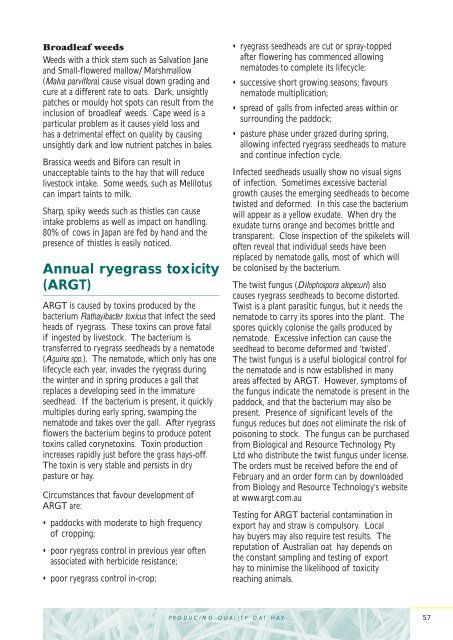Create successful ePaper yourself
Turn your PDF publications into a flip-book with our unique Google optimized e-Paper software.
Broadleaf weeds<br />
Weeds with a thick stem such as Salvation Jane<br />
and Small-flowered mallow/Marshmallow<br />
(Malva parviflora) cause visual down grading and<br />
cure at a different rate to oats. Dark, unsightly<br />
patches or mouldy hot spots can result from the<br />
inclusion of broadleaf weeds. Cape weed is a<br />
particular problem as it causes yield loss and<br />
has a detrimental effect on quality by causing<br />
unsightly dark and low nutrient patches in bales.<br />
Brassica weeds and Bifora can result in<br />
unacceptable taints to the hay that will reduce<br />
livestock intake. Some weeds, such as Melilotus<br />
can impart taints to milk.<br />
Sharp, spiky weeds such as thistles can cause<br />
intake problems as well as impact on handling.<br />
80% of cows in Japan are fed by hand and the<br />
presence of thistles is easily noticed.<br />
Annual ryegrass toxicity<br />
(ARGT)<br />
ARGT is caused by toxins produced by the<br />
bacterium Rathayibacter toxicus that infect the seed<br />
heads of ryegrass. These toxins can prove fatal<br />
if ingested by livestock. The bacterium is<br />
transferred to ryegrass seedheads by a nematode<br />
(Aguina spp.). The nematode, which only has one<br />
lifecycle each year, invades the ryegrass during<br />
the winter and in spring produces a gall that<br />
replaces a developing seed in the immature<br />
seedhead. If the bacterium is present, it quickly<br />
multiples during early spring, swamping the<br />
nematode and takes over the gall. After ryegrass<br />
flowers the bacterium begins to produce potent<br />
toxins called corynetoxins. Toxin production<br />
increases rapidly just before the grass hays-off.<br />
The toxin is very stable and persists in dry<br />
pasture or hay.<br />
Circumstances that favour development of<br />
ARGT are:<br />
• paddocks with moderate to high frequency<br />
of cropping;<br />
• poor ryegrass control in previous year often<br />
associated with herbicide resistance;<br />
• poor ryegrass control in-crop;<br />
PRODUCING QUALITY OAT HAY<br />
• ryegrass seedheads are cut or spray-topped<br />
after flowering has commenced allowing<br />
nematodes to complete its lifecycle;<br />
• successive short growing seasons; favours<br />
nematode multiplication;<br />
• spread of galls from infected areas within or<br />
surrounding the paddock;<br />
• pasture phase under grazed during spring,<br />
allowing infected ryegrass seedheads to mature<br />
and continue infection cycle.<br />
Infected seedheads usually show no visual signs<br />
of infection. Sometimes excessive bacterial<br />
growth causes the emerging seedheads to become<br />
twisted and deformed. In this case the bacterium<br />
will appear as a yellow exudate. When dry the<br />
exudate turns orange and becomes brittle and<br />
transparent. Close inspection of the spikelets will<br />
often reveal that individual seeds have been<br />
replaced by nematode galls, most of which will<br />
be colonised by the bacterium.<br />
The twist fungus (Dilophospora alopecuri) also<br />
causes ryegrass seedheads to become distorted.<br />
Twist is a plant parasitic fungus, but it needs the<br />
nematode to carry its spores into the plant. The<br />
spores quickly colonise the galls produced by<br />
nematode. Excessive infection can cause the<br />
seedhead to become deformed and ‘twisted’.<br />
The twist fungus is a useful biological control for<br />
the nematode and is now established in many<br />
areas affected by ARGT. However, symptoms of<br />
the fungus indicate the nematode is present in the<br />
paddock, and that the bacterium may also be<br />
present. Presence of significant levels of the<br />
fungus reduces but does not eliminate the risk of<br />
poisoning to stock. The fungus can be purchased<br />
from Biological and Resource Technology Pty<br />
Ltd who distribute the twist fungus under license.<br />
The orders must be received before the end of<br />
February and an order form can by downloaded<br />
from Biology and Resource Technology's website<br />
at www.argt.com.au<br />
Testing for ARGT bacterial contamination in<br />
export hay and straw is compulsory. Local<br />
hay buyers may also require test results. The<br />
reputation of Australian oat hay depends on<br />
the constant sampling and testing of export<br />
hay to minimise the likelihood of toxicity<br />
reaching animals.<br />
57

















